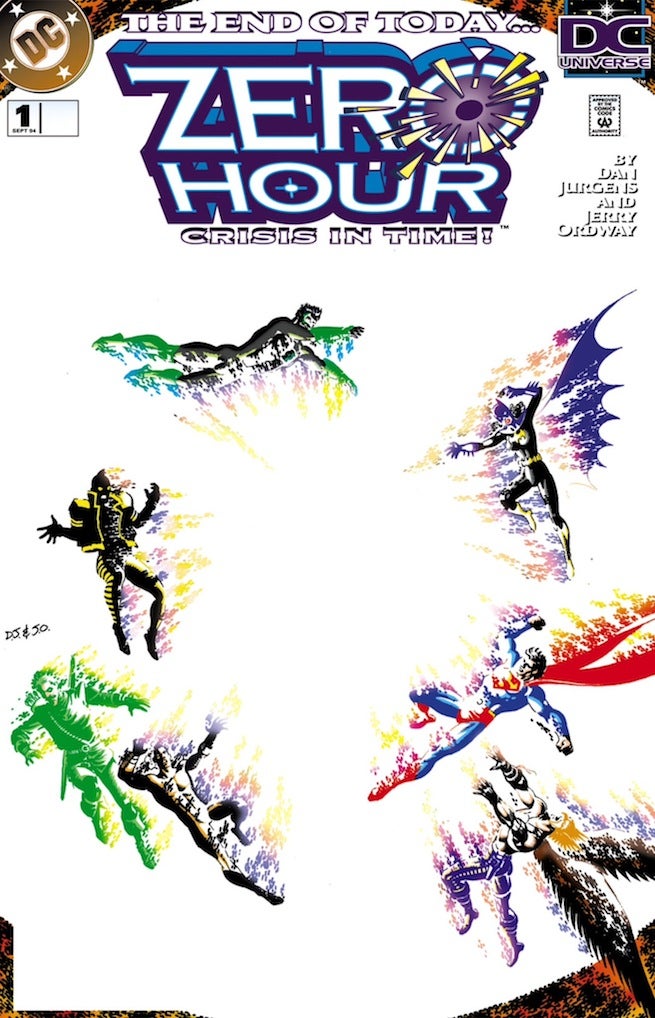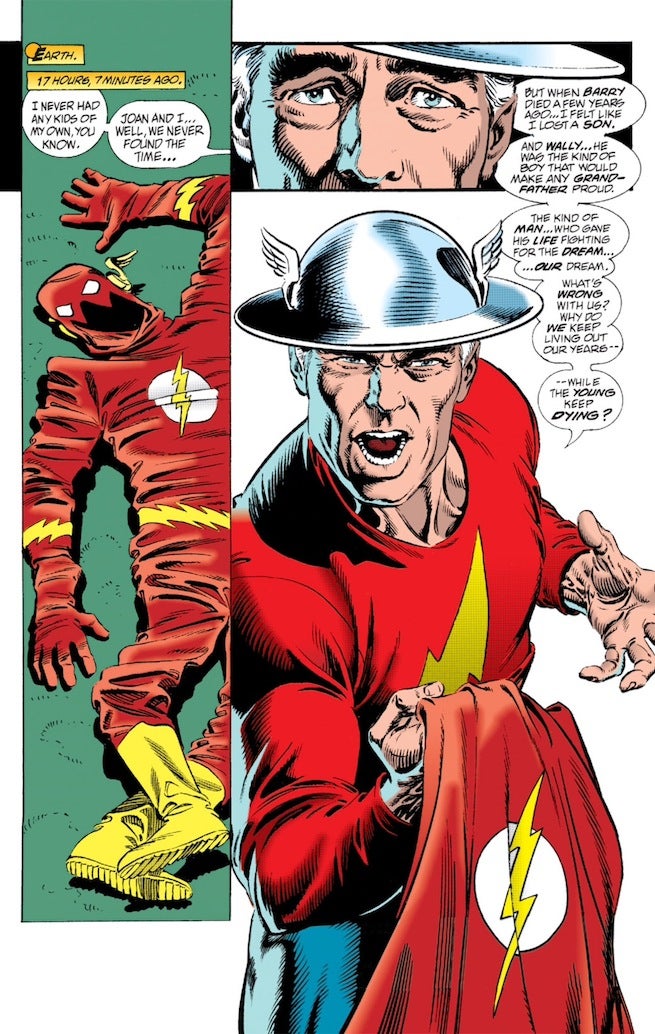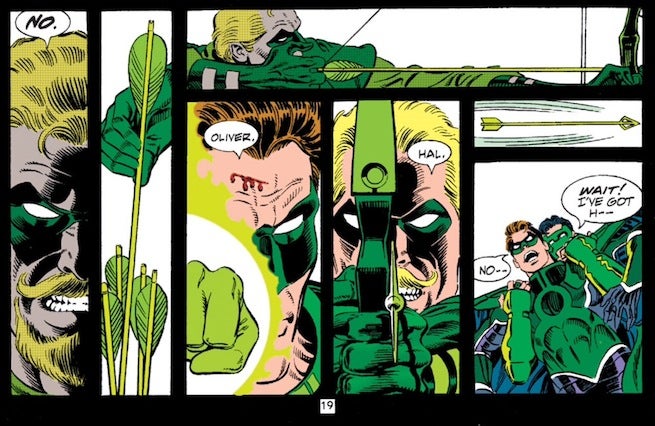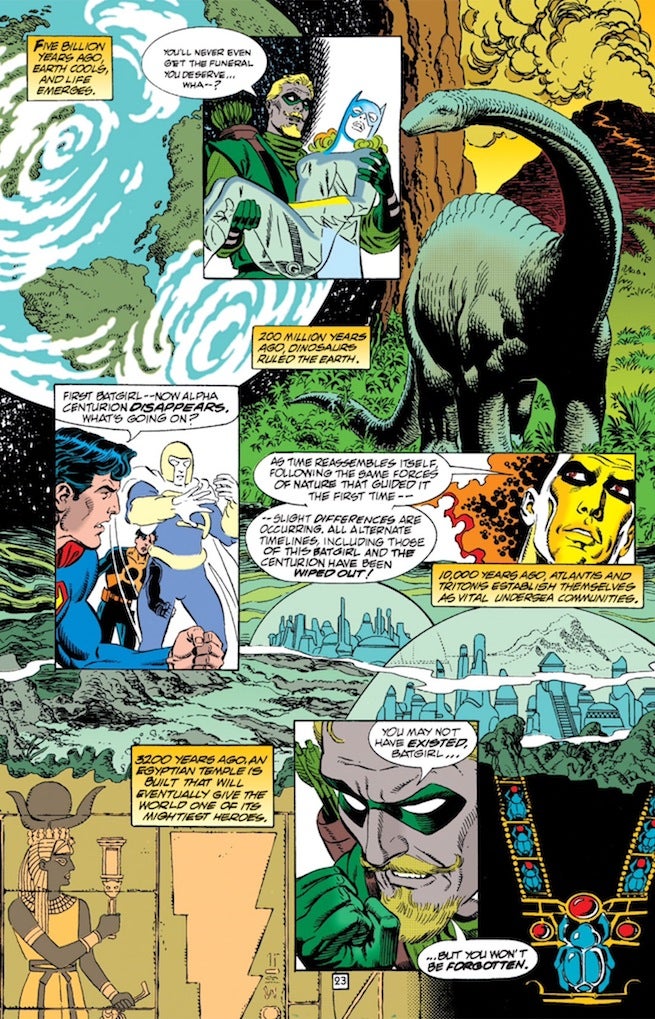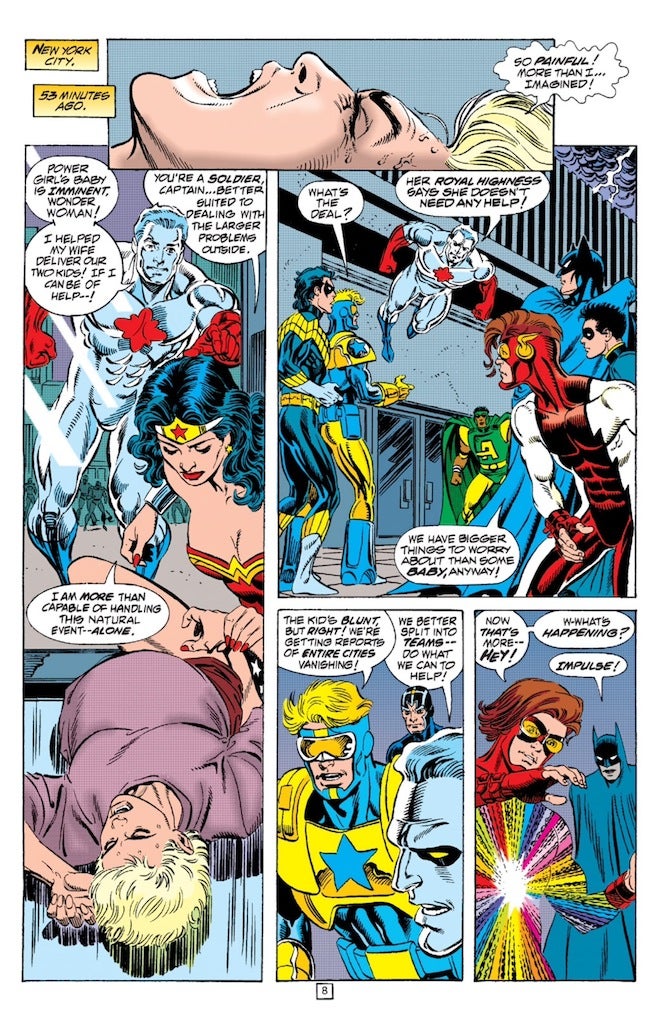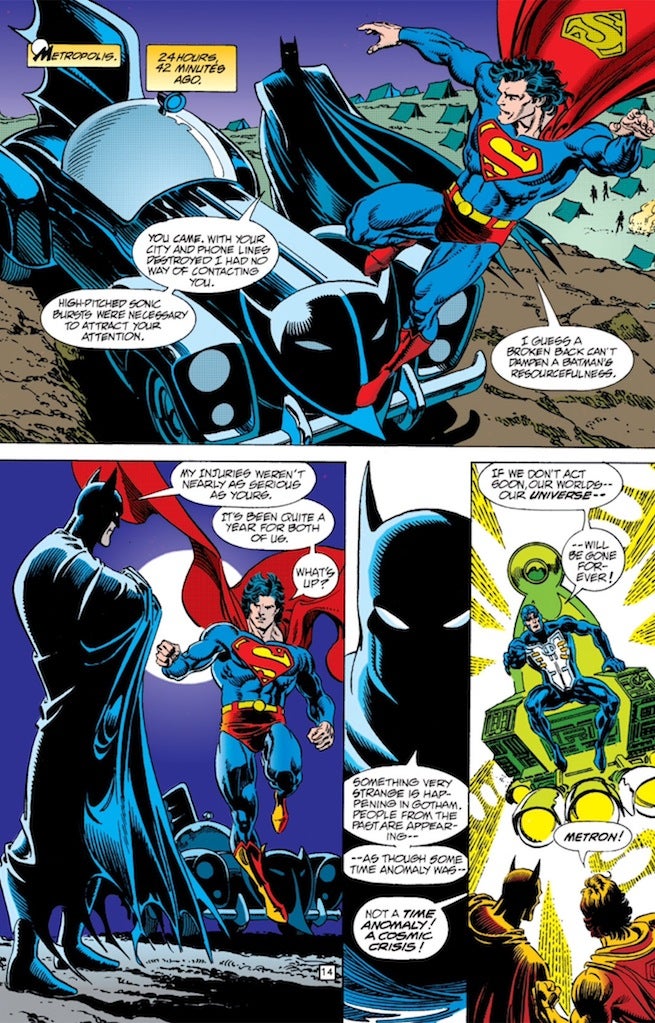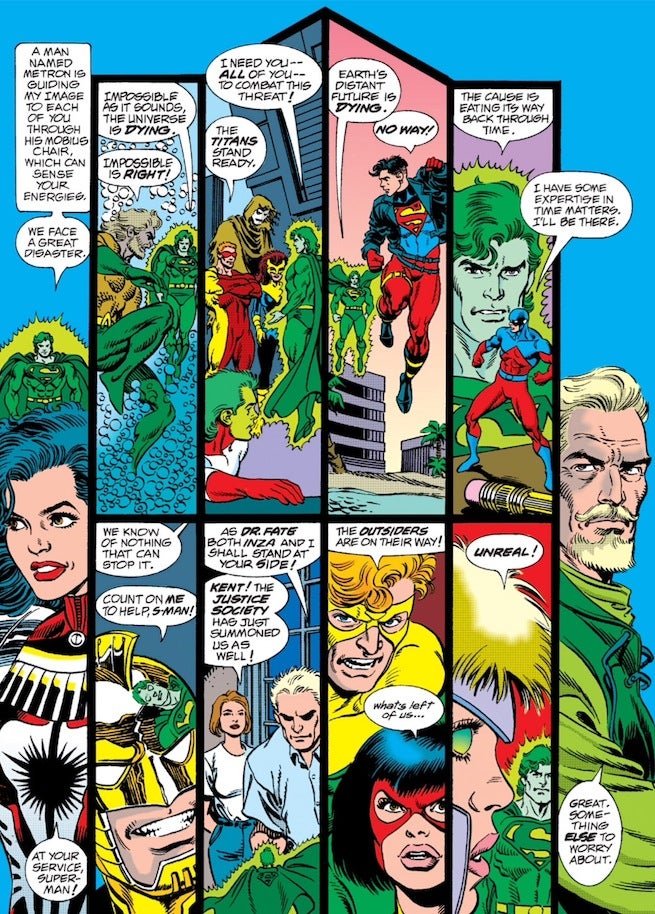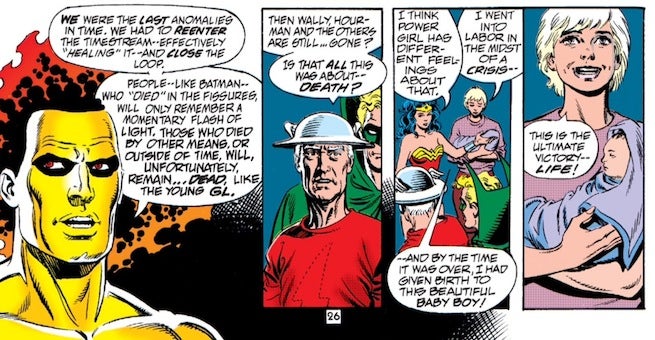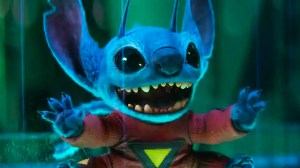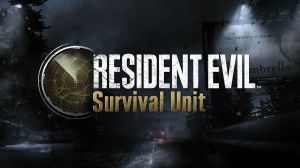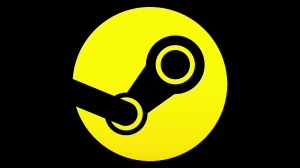The five-part Zero Hour: Crisis in Time miniseries was published by DC in 1994 as a pseudo-sequel of sorts to the landmark Crisis on the Infinite Earths. In this story, which was written and penciled by Dan Jurgens and inked by Jerry Ordway, DC’s heroes face a new threat that’s deleting time and space in both directions. This threat is ultimately revealed as former Green Lantern-turned supervillain Hal Jordan, who goes by the name Parallax.
Videos by ComicBook.com
As part of the marketing gimmick for the series, Zero Hour was published in reverse order, i.e. the first issue was actually numbered #4 and the rest of the mini worked its way back to #0. Also, all of DC’s ongoing series (Superman, Batman, Aquaman, etc.) ran #0 issues (sound familiar?) while Zero Hour was being released.
So let’s take work our way back through this series and determine if Zero Hour is 90s Nirvana or comes up empty.
The Good
1. Crisis Clean-Up
While the intended purpose of Crisis on the Infinite Earths was to clean-up and streamline the incongruous elements of DC’s continuity, the series inadvertently left behind some new issues that needed to be addressed. For example, some of the series and characters that were rebooted or completely reimagined after Crisis (Superman, Batman, etc.) were slowly phased into DC’s continuity over the course of a few years after the landmark series ended – meaning there were still technically multiple versions of the character. Probably the most egregious example of this discombobulation came with Hawkman. A new Hawkman wasn’t introduced until 1989, while the post-1986 iteration of the character was still operating as the Golden Age version.
Zero Hour addresses these issues by merging these multiple character iterations into one definitive version. Of course, in doing this, new continuity inconsistencies pop up, but Zero Hour at least gets points for trying to clean things up.
2. The Parallax Reveal
Through Zero Hour’s first three issues, the primary antagonist appears to be Extant, formerly Hawk of Hawk and Dove fame (and later known as Monarch). That’s all well and good, but for a storyline that is supposed to function as a sequel for Crisis, which features the super-powerful Anti-Monitor, Zero Hour needed a tad more juice. Enter crazy Hal Jordan, or Parallax to you.
Prior to Zero Hour, Jordan had gone over the deep end, leaving a trail of dead bodies behind during Green Lantern “Emerald Twilight” arc (which also introduced Kyle Rayner as the new Green Lantern). Zero Hour marks Parallax’s official coming out party. His inclusion provides a clear reason as to why reality is being wiped out – Hal wants to remake the universe as part of a backwards ways of absolving himself of the sins he committed when he went bananas in “Emerald Twilight.” While Parallax could have used a little more fleshing out in Zero Hour, his inclusion does add some more credence and gravity to the event when compared to Extant.
3. The Golden Oldies
One of Zero Hour’s subplots involves Extant aging a number of the Justice Society characters, leaving them either withered or dead. Yet, in the face of this adversity, the Golden Age Flash, Jay Garrick, gets a fantastic moment where he looks upon a discarded Flash costume that he believes to be Wally West’s (who is presumed dead) and then thinks back to Barry Allen’s death in Crisis. “Why do we keep living out our years while the young keep dying?” Garrick asks, adding an element of nuance and quiet somberness in this otherwise “everything is ending” storyline.
4. Green Arrow and Parallax
Zero Hour could have done a much better job establishing the prior relationship between Oliver Queen, aka, Green Arrow, and his former teammate Hal Jordan, but Jurgens and Ordway still find a way to tug on the heartstrings a bit when they have Queen deliver the definitive blow that defeats Parallax. Queen clearly struggles with firing that arrow at his old buddy, but he recognizes the fact that Jordan, as he knew him, no longer exists. In the wake of the DC Universe’s victory against extinction, Queen is in no mood to celebrate, which helps keep the story grounded in the inherent drama of Hal’s degeneration into villainy.
The Bad
1. Still Lacking Clarity
Parallax is defeated and time and reality is no longer disappearing, but there are still a number of unresolved aspects to Zero Hour’s narrative. Most notably is the presumed death of Wally West. Sure, Flash #0 goes on to explain that Wally is very much alive (while also setting up the very excellent “Terminal Velocity” arc by Mark Waid), but it’s expecting a lot for your readers to go out and purchase every single tie-in issue. The least Jurgens and Ordway could have done is let readers know that Wally was alive but they should read Flash for more information.
2. New Inconsistencies
As mentioned earlier, while Zero Hour set out to resolve some of the dangling inconsistencies left behind by Crisis, it introduced a number of new issues to DC’s continuity. For example, the storyline Armageddon was included as part of DC’s new timeline, but Armageddon could have never existed without some of the timelines that were ultimately erased by Zero Hour. And while definitively landing on only one Hawkman was a good thing, it still took the Rosetta Stone to determine who actually was this character.
3. Where’s Wonder Woman
It’s not unusual for certain popular characters to get lost in the shuffle during these big events, but Wonder Woman’s role was curiously small in Zero Hour. In fact, her most significant moment involves her pushing aside Captain Atom in order to help Power Girl deliver her baby. That’s seriously the best the creators were able to do with Wonder Woman; acting as midwife?
Things That Make You Go Hmmm…
1. How About Those 90s
In the very beginning of the story, Batman and Superman share a bromantic moment where they both talk about the various injuries they sustained over the past year – Batman and his broken back courtesy of Bane, and Superman and that whole being dead thing. I don’t believe Aquaman had his hook for a hand yet, or otherwise he could have joined in.
2. We Get a Montage
Zero Hour is hardly the only event/miniseries to utilize this technique, but rather than spend the proper time establishing why certain heroes are aligning with Superman to fight this mysterious force that’s wiping out time and reality, we instead get a rather lazy montage page showing the likes of Aquaman, Superboy and Green Arrow joining up.
3. Umm… Thanks Power Girl
Zero Hour ends with Golden Age Flash still mourning the loss of Wally West. That’s when Power Girl tries to convince everyone that everything is much better because she managed to give birth while the world was supposedly ending. I’m sure everyone was happy for her, but could she have maybe waited a few minutes and let some wounds heal before announcing her big news? Yes, it’s a moment of optmism, but the way Jurgens and Ordway juxtapose it with Wally’s alleged death is just odd.
Final Verdict: C-
A lot of the series that were rebooted or relaunched in Zero Hour’s wake were soon cancelled due to poor sales. However, it’s worth noting that the storyline helped lead to one of the greatest runs in modern comics, James Robinson’s Starman, which was born out of this series. Still, Starman alone is not enough to consider Zero Hour’s legacy on the DC Universe and 90s comics in general a good one. It still failed to clean up some of the inconsistencies with DC’s continuity and doesn’t deliver very many satisfying superhero moments typical of big blockbuster events like these.


